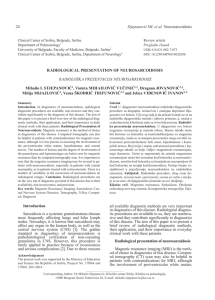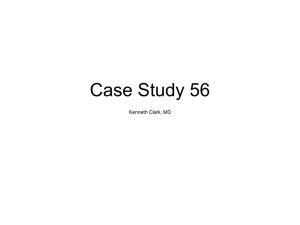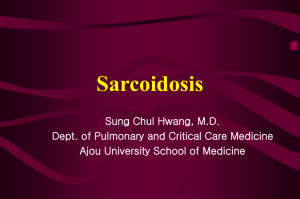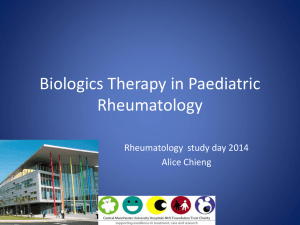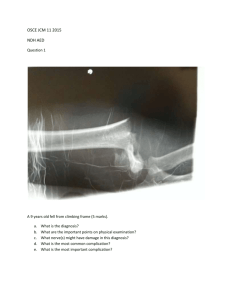Response to reviewers` Comments
advertisement
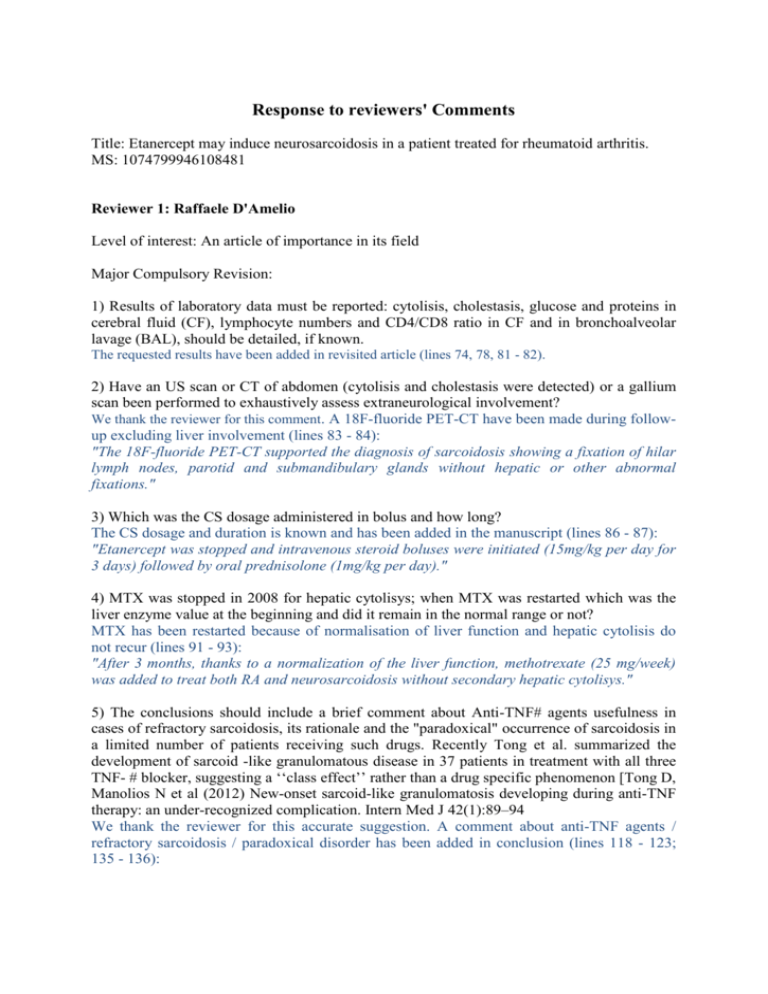
Response to reviewers' Comments Title: Etanercept may induce neurosarcoidosis in a patient treated for rheumatoid arthritis. MS: 1074799946108481 Reviewer 1: Raffaele D'Amelio Level of interest: An article of importance in its field Major Compulsory Revision: 1) Results of laboratory data must be reported: cytolisis, cholestasis, glucose and proteins in cerebral fluid (CF), lymphocyte numbers and CD4/CD8 ratio in CF and in bronchoalveolar lavage (BAL), should be detailed, if known. The requested results have been added in revisited article (lines 74, 78, 81 - 82). 2) Have an US scan or CT of abdomen (cytolisis and cholestasis were detected) or a gallium scan been performed to exhaustively assess extraneurological involvement? We thank the reviewer for this comment. A 18F-fluoride PET-CT have been made during followup excluding liver involvement (lines 83 - 84): "The 18F-fluoride PET-CT supported the diagnosis of sarcoidosis showing a fixation of hilar lymph nodes, parotid and submandibulary glands without hepatic or other abnormal fixations." 3) Which was the CS dosage administered in bolus and how long? The CS dosage and duration is known and has been added in the manuscript (lines 86 - 87): "Etanercept was stopped and intravenous steroid boluses were initiated (15mg/kg per day for 3 days) followed by oral prednisolone (1mg/kg per day)." 4) MTX was stopped in 2008 for hepatic cytolisys; when MTX was restarted which was the liver enzyme value at the beginning and did it remain in the normal range or not? MTX has been restarted because of normalisation of liver function and hepatic cytolisis do not recur (lines 91 - 93): "After 3 months, thanks to a normalization of the liver function, methotrexate (25 mg/week) was added to treat both RA and neurosarcoidosis without secondary hepatic cytolisys." 5) The conclusions should include a brief comment about Anti-TNF# agents usefulness in cases of refractory sarcoidosis, its rationale and the "paradoxical" occurrence of sarcoidosis in a limited number of patients receiving such drugs. Recently Tong et al. summarized the development of sarcoid -like granulomatous disease in 37 patients in treatment with all three TNF- # blocker, suggesting a ‘‘class effect’’ rather than a drug specific phenomenon [Tong D, Manolios N et al (2012) New-onset sarcoid-like granulomatosis developing during anti-TNF therapy: an under-recognized complication. Intern Med J 42(1):89–94 We thank the reviewer for this accurate suggestion. A comment about anti-TNF agents / refractory sarcoidosis / paradoxical disorder has been added in conclusion (lines 118 - 123; 135 - 136): "Interestingly some TNFα-blocker-induced sarcoidosis patients did not relapse after rechallenging [7]. However, there are biological arguments to support imputability ... have been actually reported in the literature." "By contrast some studies reported refractory sarcoidosis cases successfully treated by TNFα blockers [6], especially adalimumab and infliximab." 6) In the 2 previous cases of neurosarcoidosis occurred during Anti-TNF# use reported in the literature, infliximab and adalimumab were used and the presented case was the first in which etanercept was involved. Indeed, the conclusions would benefit from some discussion about the differences between etanercept and infliximab/adalimumab; infact etanercept partially preserve the mechanisms leading to granuloma formation, and this aspect could explain its lack of efficacy in granulomatous disorders like Crohn’s disease and in refractory sarcoidosis. We thank the reviewer to raise this point. Indeed, our case is the first in which etanercept was involved in neurosarcoidosis during anti-TNF. Some explanations have been added in the manuscript concerning differences between etanercept and infliximab/adalimumab and the risk of developing paradoxical granulomatous disorders (lines 135 - 140): "By contrast some studies reported refractory sarcoidosis cases successfully treated by TNFα blockers [6], especially adalimumab and infliximab. Indeed, monoclonal TNFα blockers antibodies … explain a lack of efficacy of etanercept in granulomatous diseases (e.g. refractory sarcoidosis, crohn’s disease)." 7) No mention was made about the diagnostic issue between probable or possible neurosarcoidosis, that should be debated in presence of the negative histology for noncaseating epitheloid granulomas in peripheral tissue. Diagnostic criteria for neurosarcoidosis have been more recently revised ( Marangoni S,Argentiero V, Tavolato B. Neurosarcoidosis. Clinical description of 7 cases with a proposal for a new diagnostic strategy. J Neurol 2006; 253:488–495) comparing to the cited article of Zajicek JP et al . Discussion about the diagnosis and the histological results has been completed in the revised version of the manuscript (lines 99 - 112) in the light of the new diagnostic strategy proposed by Marangoni et al: "Since we did not obtain histological confirmation, this case is not a definite neurosarcoidosis according to …our case is still considered as probable (2)." Minor Essential Revisions 1) The wide range of neurological conditions, associated with TNF-# blocker therapy, other than neurosarcoidosis, including multiple sclerosis, polycranial neuritis, and chronic inflammatory axonal polyradiculoneuropathy, should be debated. We take this specific point. A comment has been added in our revision (lines 141 - 146): "In addition to paradoxical neurosarcoidosis, other neurological adverse events have been reported … who present any new neurological symptoms." 2) Some language corrections are needed. In particular: in the abstract 40 year old instead of 40 years old in the case presentation eye dryness instead of eyes dryness, Human Immunodeficiency Virus instead of Human Immunodeficient Virus, meningitis instead of meningitides, lymphocytic instead of lymphocytes, steroid boluses instead of steroids boluses In the conclusions arguments may be replaced by evidences, did not relapse instead of did not relapsed, sarcoidotic instead of sarcoidosic patients. We apologize for this point. Grammar and vocabulary have been corrected throughout the manuscript (lines 43, 71, 76, 78, 81, 86, suppression, 119, 131). Reviewer 2: HIROKI WAKABAYASHI This may be an exceptional and second case of neurosarcoidosis occurring in a RA patient treated with etanercept. The third cases treated with TNF inhibitor will be reported if definite or probable neurosarcoidosis. The manuscript is very interesting. Level of interest:An article of importance in its field. P6, line15” As in our case, it is not always possible to obtain histological confirmation but strong and converging arguments can lead to the diagnosis.” Why strong and converging arguments can lead to the diagnosis? Despite the absence of histological confirmation due to biopsy, diagnosis of neurosarcoidosis has been made by excluding differential diagnoses and several positive arguments that supported neurosarcoidosis diagnosis (lines 99 - 112): "Since we did not obtain histological confirmation, this case is not a definite neurosarcoidosis according to our case is still considered as probable (2)." Which in serum or CSF was an increased level of ACE? Increased level of angiotensin-converting enzyme was found in serum (lines 89 - 91): This is now indicated. "Nevertheless, diagnosis of neurosarcoidosis was further supported by an increased level of angiotensin-converting enzyme in serum (77UI/L [normal value < 68 UI/L])." Please show what criteria was diagnosed as definite or probable neurosarcoidosis. The diagnosis of probable neurosarcoidosis has been made rather than definite neurosarcoidosis because of absence of histological confirmation but several converging arguments leading to diagnosis (lines 99 - 112): "Since we did not obtain histological confirmation, this case is not a definite neurosarcoidosis according to our case is still considered as probable (2)."
